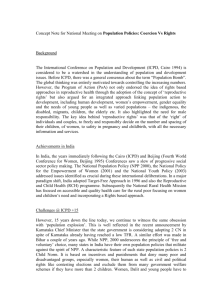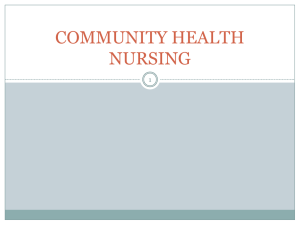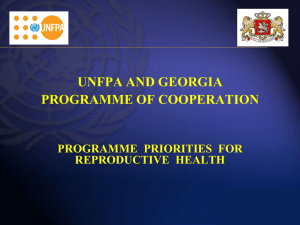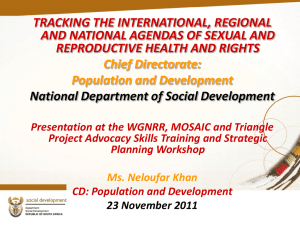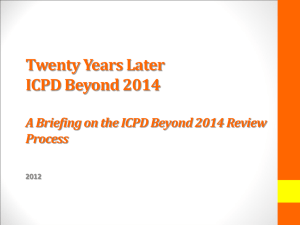U.N. Role in Reproductive Healthcare and Female Empowerment.
advertisement
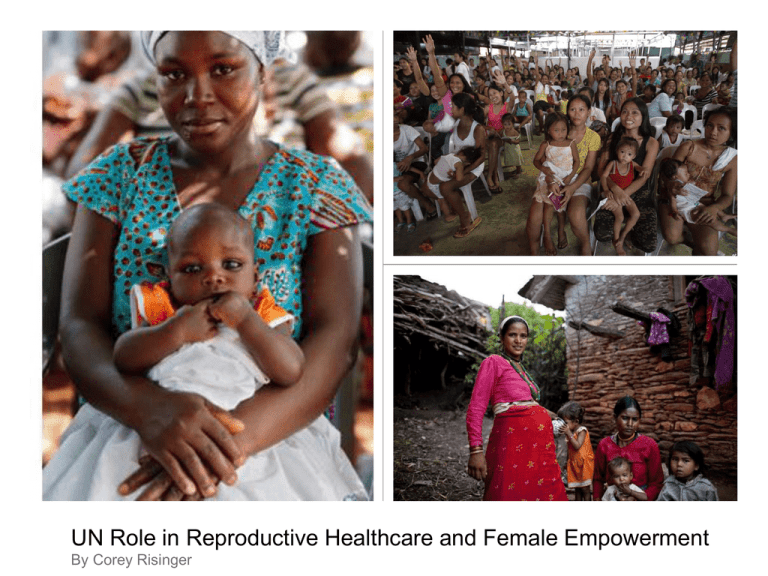
UN Role in Reproductive Healthcare and Female Empowerment By Corey Risinger Restricted: Demanding Reproductive Healthcare for the 21st Century • Tenuous state of internationallyaccessible reproductive healthcare • History of UN involvement in female empowerment and the provision of healthcare • Shortcomings of current tactics • Potential Solutions Fundamental Problems • Developing regions are trending towards decentralization of healthcare • A lack of knowledge and accessibility to contraception yields millions of unintended pregnancies a year • Infants delivered without sufficient medical care are predisposed to additional health risks Part of a UN Millennium Dev. Goal Series of Advertisements • Funding does not meet needs for reproductive healthcare or preventative education Today’s Reality • Over 60 million girls become child brides • 1/4 women experience sexual or physical violence during pregnancy • 603 million women live in countries where domestic violence is not yet considered a crime • Strides have been made... Previous UN Intervention • 1975 Mexico City Conference • 1980 Copenhagen Conference (First significant exposure for RHC) • 1985 World Conference in Nairobi • 1994 International Conference on Population and Development • Millennium Development Goals (1990-2015) • 1995 Beijing Conference • 2005 World Summit • ICPD Beyond 2014 Mexico City Conference • First formal international exposure for the topic of women’s health: • Discussed female safety and empowerment, especially in the context of domestic violence and gender prejudices • Incentive for bill aimed to curb discrimination against women, establishing more prominent roles for all genders in the workplace and home June 19, 1975 June 19, 1975 World Conference, Copenhagen December 1979- UN passed Convention on the Elimination of all forms of Discrimination against Women - “Bill of Rights” for Women, binds 165 states - 3 priorities: 1) education; 2) employment; 3) accessible health services World Conference, Nairobi Violence against women ought to be acknowledged as a worldwide issue: -effects more than the direct parties involved -must be addressed as a matter of human rights International Conference on Population and Development Cairo, Egypt- 1994 • Explicitly dealt with the provision of healthcare • 179 participating member states of the UN • Continuation of theme of women’s empowerment • Added emphasis on the reduction of STIs • Recognized preventative healthcare and family planning’s crucial role in preventing maternal and infant mortality • aimed to provide family planning by 2015 Millennium Conference • UNFPA’s Master Plans for Development • Goal 3: Promote gender equality, women’s empowerment -address gender disparities in education (primary and secondary) by 2005, all levels of education by 2015 -sub-points dealing with empowerment: level ratios of girls to boys in education, in wage employment in nonagricultural sectors, in number of seats held in parliament • Goal 5: Improve maternal health -Target 5.A- Reduce maternal mortality ratio by 3/4 between 1990-2015 -Target 5.B- Offer universal reproductive healthcare access by 2015 • Goal 6: Combat HIV/ AIDS -halt the spread of HIV/ AIDS and begin to reverse it by 2015 Beijing Conference 1995 -largest of the World Conferences on Women -180 government delegations/ states present -created the “Beijing Plan for Action” -identifies “Women and Health” as one of twelve “strategic objectives” World Summit, 2005 Section 12) “We reaffirm that gender equality and the promotion and protection of the full enjoyment of all human rights and fundamental freedoms for all are essential to advance development and peace and security. We are committed to creating a world fit for future generations, which takes into account the best interests of the child.” 12a) “Eliminating gender inequalities in primary and secondary education by the earliest possible date and at all educational levels by 2015.” ICPD Beyond 2014 • Established the ICPD Programme of Action -introduced to the UN Conference on Population and Development in 2014 -states declared “progress for women is progress for all” Remaining Dilemmas • Need for professional medical training that is regionally sensitive • Antenatal care lacking • Family Planning requires improvement • Adolescent Childbirth Medical Gaps to be Met: Delivery • 26 million/ 135 million live births in 2011 were delivered alone, without adequate medical-care • 55% (1990) to 66% (2011) • Percentages vary according to region: E. Asia (100%), C. Asia (97%), S. Asia and sub-Saharan Africa (~50%) • Rural areas are particularly vulnerable • Because of lackluster medical care A rural pregnancy in Nepal Antenatal Care • World Health Organization minimum recommendation for pregnant women= 4 visits • Tetanus Toxoid vaccination, screening for infections, indicators of warning signs during pregnancy • Adapted to include regional illnesses (ex. malaria) Only 1/2 women in developing regions meet the WHO standards. Family Planning • Includes counseling, provision of supplies, etc. • 1990: 15% unmet vs. 2011: 12% • ***By 2015, total demand for family planning among married is expected to exceed 900 million women. • 62% of women in developing regions- in a partnership or marriage- using contraception (2011) • Developing regions/ rural areas: 1) female sterilization; 2) Intrauterine devices (IUD) Factors in the movement to provide reproductive healthcare • Social Dictates -Cultures may idolize pregnancy -Perceived as becoming an adult, gaining status, or a method for escape from abusive families Case Study (Guttmacher Institute, 2010): 67% of married adolescents in sub-Saharan Africa desired pregnancy or were intentionally pregnant Gap to be filled: Need to instill an identity beyond motherhood to young adults • Peer and Educational Influence Women who remained in school were less likely to be adolescent brides or mothers “The first step is to analyse not only why adolescent girls suffer from high rates of maternal morbidity and death, but also why they are becoming pregnant... Amidst many other factors, adolescent pregnancy might be due to a lack of comprehensive sexual education; gender norms that reinforce early pregnancy; early marriage; high levels of sexual violence; a lack of youth-friendly health services; lack of affordable and accessible contraception; or a combination of the above.” -2012 report from the Office of the High Commissioner for Human Rights Adolescent Childbirth • Psychological impact: 90% of adolescents who give birth are married, depression, coerced sexual relations, stress from being unprepared for the identity transformation of marriage • Response to aforementioned social dictates Sub-Saharan Africa Nepal Causal Analysis of Adolescent Pregnancy Perspectives on Teenage Pregnancy • “The reality is that people are very judgmental, and that’s how human beings are. To hear that even after all your accomplishments. . .all the stuff you’ve gone through to pass these hurdles, to become a better person. . .people can be very unforgiving because they are going to remember ‘Oh, she had a baby when she was 15’.” -Tonette, 21, pregnant at 15, Jamaica • “Things are gradually changing. Hopefully customs like atta-satta (exchange marriages) and child marriages will be totally gone by the time my daughter grows up, and she will get to complete her education and marry only when she wants to.” -Komal, 18, India Inspiring Change with Social Media: Madagascar • 1/3 women become pregnant before 18 • 1/2 of the population is under 20 years-old • Manantsoa Ratsarazaka (23 year-old) founded “Tanora garan ‘Tenen” (Guarantee for Youth)- social media project • “Malagasy people are generally shy when talking about sexual matters. Most questions or concerns are ascribed to a ‘friend’ or a ‘cousin.’ Tanora garan ‘Tenen Program explained to UN representative “The impact of emotional, physical, and sexual abuse on contraceptive method selection and discontinuation” by Allsworth JE, Secura GM, Zhao Q, Madden T, Peipert JF 1) Hormonal IUD 2) Copper IUD 3) Implant 4) Shot 5) Birth Control Pill 6) Contraceptive Patch 7) Contraceptive Ring 8) Condoms Choose Your Future Program in Nepal • UNFPA-supported • Instructors personally visit in-laws and parents to explain the empowerment program rooted in education • Personal hygiene and reproductive health lessons; encourage the delay of pregnancy and the re-enrollment of girls in school (free through grade 10 as of 2009) Choose Your Future • “Early marriage is our custom, and we didn’t know it was wrong before the teacher explained things to us,” said Malati Sebat. Potential UN Solutions 1) New legislative body under the UNFPA 2) Development of RHC facilities 3) Education of local medical professionals through UNsponsored conferences 4) Expanded sexual educationthrough schools and RHC centers 5) Media Campaigns Application of the WHO’s 6 building blocks • Safe health services • Trained health workforce • Reliable health information system/ infrastructure • Equitable technologies • Health financing system • Legislative leadership Particular target: migrant/ religious communities Sexual Education • Local educators/ grassroots programs can better serve regional cultures • In Nepal, teachers were first faced with staunch opposition, but they were able to relate to mothers. • Sexuality education DOES NOT hasten initiation of or increase sexual activity (UNESCO 2009) • In and out of school educational opportunities (out-of-school ones facilitated by RHC centers) Promise of Media Campaigns • Tailored to specific regions (as far as identifying most effective/ accessed forums and methods of presentation) • As seen by Ratsarazaka’s successful program in Madagascar, social media projects may be a lasting solution in the 21st century. Translated UN poster for July 11 (World Population Day) Restricted: Demanding Reproductive Healthcare for the 21st Century Metaphorical significance of the wire, caution tape- confined torso 1) Resolution from the Mexico City Conference, 2) Secretary General’s Report from the Nairobi Convention Bibliography ICPD Beyond 2014, Resolution 65/234: http://icpdbeyond2014.org/uploads/browser/files/ungass_res_65_243.pdf ICPD Beyond: http://www.un.org/ecosocdev/geninfo/populatin/icpd.htm. United Nations Population Fund: http://www.unfpa.org/public/home/about/pid/4629 http://www.unfpa.org/rh/planning.htm United Nations Women: http://www.unwomen.org/about-us/about-un-women/ Millennium Development Goals: http://www.un.org/millenniumgoals/ “New Study Finds Little Progress in Meeting Demand for Contraception in Developing World” http://www.unfpa.org/public/cache/offonce/home/news/pid/11239;jsessionid=EA3CEE93763805D1D3328C4E45C4BA74.jahia0 2 Taskforce on Women, Peace and Security: http://www.un.org/womenwatch/ianwge/taskforces/wps/history.html http://www.un.org/millenniumgoals/pdf/report-2013/mdg-report-2013-english.pdf http://www.unfpa.org/webdav/site/global/shared/swp2013/EN-SWOP2013-final.pdf http://www.choiceproject.wustl.edu/METHODS http://www.flickr.com/photos/tanoragaranteen/7844239480/in/photostream/ Study: http://www.ncbi.nlm.nih.gov/pubmed/23948012 http://www.unfpa.org/public/home/news/pid/15473
